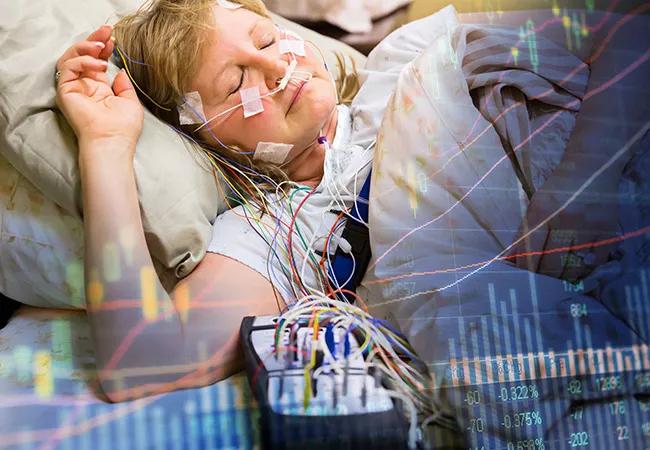Advertisement
Creating a sleep biophysiologic repository, and studying OSA/QT prolongation links

Cleveland Clinic research teams led by Reena Mehra, MD, MS, Research Director in Cleveland Clinic’s Sleep Disorders Center, recently received two funding awards that promise to advance sleep science on multiple fronts.
Advertisement
Cleveland Clinic is a non-profit academic medical center. Advertising on our site helps support our mission. We do not endorse non-Cleveland Clinic products or services. Policy
One award is making it possible to create a repository of physiologic measurements collected from more than 13 years of sleep studies performed at Cleveland Clinic. It is expected to provide researchers with valuable data to inform a variety of future sleep investigations.
The other award funds a pilot study to characterize the relationship between obstructive sleep apnea (OSA) and QT prolongation in long QT syndrome and determine whether treating OSA mitigates this potentially fatal heart arrhythmia.
“Our innovative projects have put us on the forefront of sleep science,” says Dr. Mehra. “We expect this new funding to have far-reaching effects in clinical research and the care of our patients with sleep disorders.”
The first award represents philanthropy-enabled Cleveland Clinic seed funding to help establish a multimodal neurocardiorespiratory sleep biophysiologic repository that will leverage more than 100,000 clinical sleep studies performed at Cleveland Clinic.
“The result will be a first-of-kind sleep physiologic signal registry of clinic-based sleep and neurocardiorespiratory data,” explains Dr. Mehra. “Our goal is to develop a legacy resource that informs research well into the future.”
Advertisement
The IRB-approved two-year project, which began in March 2018, involves assembling sleep and neurocardiorespiratory metrics from clinical records — including breathing, oxygen saturation, limb movements, sleep stages and heart arrhythmias — and merging them with data on medications, comorbidities and health outcomes. Patient age, sex, race and body mass index are also recorded. To safeguard patient privacy, data are analyzed only in aggregate and in a de-identified manner. Once set up, the registry is anticipated to be continuously updated as data are generated in the course of clinical care and entered into the repository.
Amassing this amount of data is a significant undertaking from a technical standpoint, Dr. Mehra notes. Systems analysts are using sophisticated data storage platforms and developing processes to develop interfaces for easy querying by investigators.
She expects the repository to be invaluable for a host of critical functions: identifying sleep biomarkers of health outcomes, providing a platform to develop and apply advanced and innovative signal processing analyses, and informing prioritization of outcomes for clinical trial design.
This clinic-based resource will complement data assembled in the National Sleep Research Resource, a large database of sleep-related data compiled from research studies. The clinical registry will be drawn from sleep studies performed at Cleveland Clinic during the course of clinical care, which Dr. Mehra expects will make it likely to capture more adverse health outcomes. In addition, because longitudinal data will be available for many patients in the Cleveland Clinic registry, her team has the potential to investigate predictors of future health outcomes.
“We look forward to analyzing registry data not only for signals of abnormality but also to better characterize healthy sleep and generate age- and sex-specific normative data,” Dr. Mehra adds.
Advertisement
Separately, the Clinical Translational Science Collaborative/National Center for Advancing Translational Sciences is funding a cross-institutional collaborative pilot study at Cleveland Clinic and MetroHealth Medical Center, also located in Cleveland, to investigate the influence of OSA on QT prolongation in long QT syndrome and cardiac electrophysiologic markers of sudden cardiac death.
QT prolongation predisposes to ventricular arrhythmias and is a well-known cause of sudden cardiac death, explains Dr. Mehra. But the effects on long QT syndrome from OSA — which depresses oxygen saturation and increases blood pressure — are not well understood.
To explore the relationship between the two conditions, Dr. Mehra is leading the pilot project in collaboration with electrophysiology and sleep colleagues. They aim to recruit patients with known long QT syndrome and OSA for 24-hour continuous ECG monitoring and overnight polysomnography. The same tests will be repeated after the subjects use continuous positive airway pressure (CPAP) therapy to assess whether CPAP helps mitigate the cardiovascular abnormality.
Subjects will include patients with the congenital form of the syndrome as well as those with QT prolongation acquired from heart disease or arrhythmogenic drugs; understanding of the acquired forms is especially limited.
Dr. Mehra intends to eventually look to the new Cleveland Clinic sleep registry for additional evidence of an association between QT prolongation and OSA. She predicts that querying old data at the same time that new data are collected will increase the strength of her team’s findings.
The QT prolongation study is anticipated to be completed in 2019, with results published shortly thereafter. If findings suggest an association, Dr. Mehra intends to pursue the investigations in more detail with a larger patient population.
She says the pathway to this project was paved by her group’s past studies of the relationship between OSA and atrial and ventricular arrhythmias (partially recapped on Consult QD here and here). “After every study, we have seen more detrimental impacts of OSA on cardiovascular markers,” she observes. “Thorough understanding and awareness of the health impacts of sleep apnea is critical to making the diagnosis and management of this condition a higher priority in patient care.”
Advertisement
Advertisement

Real-world claims data and tissue culture studies set the stage for randomized clinical testing

New grant-funded investigation illustrates impact and reach of Cleveland Clinic Brain Study

How the new longitudinal investigation could become the Framingham Heart Study of brain health

Pilot findings show good patient acceptance and safety, early hints of efficacy

Study finds high prevalence of symptoms, willingness to seek treatment

Panel outlines research priorities around a promising alternative to imaging markers

Suspected factors include antithrombotic intensity, time on device, presence of thrombocytopenia

Preclinical studies will assess whether method developed for stroke recovery curbs deficits after brain injury